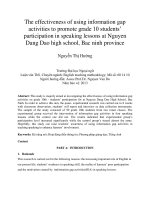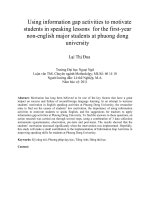Using information gap activities to motivate students in speaking lessons for the first-year non-english major students at phuong dong university
Bạn đang xem bản rút gọn của tài liệu. Xem và tải ngay bản đầy đủ của tài liệu tại đây (1.55 MB, 8 trang )
Using information gap activities to motivate
students in speaking lessons for the first-year
non-english major students at phuong dong
university
Lại Thị Đua
Trường Đại học Ngoại Ngữ
Luận văn ThS. Chuyên ngành:Methodolgy; Mã Số: 60 14 10
Người hướng dẫn: Lê thế Nghiệp, M.A.
Năm bảo vệ: 2011
Abstract: Motivation has long been believed to be one of the key factors that have a great
impact on success and failure of second/foreign language learning. In an attempt to increase
students’ motivation in English speaking activities at Phuong Dong University, the researcher
aims to find out the causes of students’ low motivation, the importance of using information
activities to motivate students to speak English, and the suggestions for teachers to apply
information gap activities at Phuong Dong University. To find the answers to these questions, an
action research was carried out through several steps, using a combination of 3 data collection
instruments (questionnaire, observation, pre-tests and post-tests). The results showed that the
students’ motivation increased significantly when the intervention was implemented. Hopefully,
this study will make a small contribution to the implementation of Information Gap Activities in
improving speaking skills for students at Phuong Dong University.
Keywords: Kỹ năng nói; Phương pháp dạy học; Tiếng Anh; Hứng thú học.
Content:
4
TABLE OF CONTENTS
DECLARATION i
ABSTRACT ii
ACKNOWLEDGEMENTS iii
TABLE OF CONTENTS iv
LIST OF CHARTS vi
PART ONE: INTRODUCTION 1
1. Rationale of the study 1
2. Aims and objectives of the study 2
3. Scope of the study 2
4. Methodology of the study 2
5. Research hypothesis 2
6. Design of the study 3
PART TWO: DEVELOPMENT 4
CHAPTER 1: LITERATURE REVIEW 4
1.1. Teaching speaking 4
1.1.1. Concepts of speaking 4
1.1.2. The role of speaking in foreign language teaching 4
1.1.3. Factors affecting English speaking ability 6
1.2 Information gap activities 6
1.2.1. Concept of information gap activities 7
1.2.1.1. Concept of information gap 7
1.2.1.2. Concept of information gap activities 7
1.2.2. Benefits of information gap activities 8
1.2.3. Teachers’ roles in information gap activities 9
1.2.4. Forms of information gap activities 10
1.2.5. Some popular information gap activities 11
CHAPTER 2: THE STUDY
2.1. An action research 13
2. 2. Research questions 13
2.3. The informants 13
2. 4. The action research procedure 14
2. 5. Description of Data Collection Instruments 16
2.5.1. Questionnaires 16
2.5.2. Observations 17
2.5.3. Tests 17
5
CHAPTER 3: DATA ANALYSIS AND DISCUSSIONS 18
3.1. Data collected from preliminary investigation stage – Questionnaire 1 18
3.1.1. Students’ attitude towards speaking skill 18
3.1.2 Factors causing students’ low motivation in speaking English 20
3.2. Intervention 21
3.2.1. The aims of the intervention 21
3.2.2. The intervention of information gap activities 21
3.3. Data collected from the intervention stage 26
3.3.1. Data collected from Observation sheets 26
3.3.2. Data collected from Questionnaire 2 27
3.3.2. Data collected from the tests 29
3.3.2. Data from pre-test 29
3.3.2. Data from post-test 30
PART THREE: CONCLUSION AND SUGGESTION 33
1. Summary of the study 33
2. Suggestions for the teachers 33
3. Limitations and suggestions for further research 35
REFERENCES 36
APPENDICES
APPENDIX 1: Questionnaire 1 I
APPENDIX 2: Questionnaire 2 III
APPENDIX 3: Observation sheet 1 – Overall class motivation IV
APPENDIX 4: Data on overall class motivation V
APPENDIX 5: Samples of the tests VI
6
PART I. INTRODUCTION
1. Rationale of the study
It is undeniable that English has been an essential means of communication and
more and more Vietnamese students are aware of the importance of English to their study
and their future. The ability to communicate in English clearly and efficiently contributes
to the success of the learners at school and success later in every phase of life. Speaking
plays an important role because without it, communication cannot take place directly
between people. However, speaking is generally considered the most difficult to learn
among the four skills in English language learning.
In order to teach the students English speaking so that they become more interested
in and maintain their interest in speaking learning. The English teachers should provide a
rich environment where meaningful communication can take place. Communication occurs
when there is lack of information between or among a group of people. They have to
exchange to share the information they have with other people. The efficient activities to
motivate students in speaking lessons are Information Gap Activities. This kind of activity
makes students more active in learning process and at the same time makes their learning
more meaningful and interesting.
At Phuong Dong University, non-English major students have to learn English as a
compulsory subject. At the end of the term, students will be examined on four skills
including listening, speaking, reading and writing. Speaking is considered as an important
skill which accounts for 25% of the total mark in the final test. In the final test, students
work in pairs to make a conversation about a given situation and then discuss a given topic.
Most of the students do not know how to make a conversation; they are very passive in
making a conversation. One of the reasons for this situation is that they lack practice in
using English in real communication situations. These students come from different
provinces with different language levels. When they were at high school, they got used to
Translation Grammar teaching method in which the teachers focused on the rules of
grammar structures and practiced the drills to remember those structures. They did not
have chances to practice speaking skills. When entering university, students have
awareness of the roles of English to their future. They themselves have changed the ways
7
to learn English. However, the teachers must find out suitable techniques which create a
need for students to use the structures they have learnt to communicate with each other to
make a meaningful conversation. In my opinion, one effective solution to this problem is
using Information Gap Activities to encourage students to use English for communicating.
The benefits of this technique to my students have aroused my interest and encouraged me
to carry out this research “Using Information Gap Activities to motivate students in
speaking lesson for the first-year non-English major students at Phuong Dong
University”. Hopefully, this study will make a small contribution to the implementation of
Information Gap Activities in improving speaking skills for students at Phuong Dong
University.
2. Aim and objective of the study
Within a framework of a minor thesis, the study is aimed at using information gap
activities to motivate students in speaking lessons for the first-year non-English major
students at Phuong Dong University. In order to study the subject matter deeply, the writer
focuses on:
- Describing the importance of Information Gap Activities to motivate students to speak
English
- Using Information gap Activities to motivate students in speaking lessons
- Providing suggestions for English teachers to prepare English speaking lessons at Phuong
Dong University.
3. Scope of the study
Due to the limit of the thesis, the study cannot cover all the speaking activities, but
focus on information gap activities to motivate students in speaking lessons. The study was
conducted on the first-year non-English major students at Phuong Dong University.
4. Methodology of the study
The method employed in this study is an action research, with the uses of three
instruments: observations, questions and pre-tests and post-tests. All comments, remarks,
recommendations and conclusion are based on the data analysis.
The combination of different instruments used in this research would help to gain
reliable data and a close investigation into the problems that the students were having
8
5. Research hypothesis
Students lack practice in speaking English in real communicating situations is one
of the main reasons for the students’ inability to make a meaningful conversation. One
solution is using information gap activities to motivate students. The questions to be dealt
with are:
1. What are the causes of the students’ low motivation in English speaking activities?
2. What is the importance of using information gap activities in motivating students in
speaking lessons?
3. What suggestions are given for teachers to apply information gap activities at Phuong
Dong University?
6. Design of the study
The study is intended to consist of three parts as follows:
Part I is the introduction which give reasons for choosing the thesis, aims and objects and
scope of the study as well as the methodology and research hypothesis of the study
Part II is the development which will be divided into three chapters:
- Chapter I: LITERATURE REVIEW provides concepts of teaching speaking and the
concepts of information gap activities.
- Chapter II: METHODOLOGY provides the readers with the definitions of the action
research, the data collection instruments. Detailed information about the research
procedure and the participants of the study is also presented.
- Chapter III: DATA ANALYSIS AND DISCUSSIONS analyzes the data collected from
the preliminary investigation stage to form the hypothesis of the study. An intervention
plan is worked out and implemented. The data from the intervention stage are collected
and analyzed to make an evaluation of the effectiveness of the intervention.
Part III is the Conclusion which reviews the study, presents the suggestions for the
teacher, the limitations of the study and suggestions for further study.
41
REFERENCES
1. Doff. A. (1996). Teach English: Trainer’s handbook. GB: Cambridge University Press
2. Gardner, R. C, & Lambert, W. (1972). Attitudes and Motivation in Second Language
Learning. Rowley. MA: Newbury House.
3. Gardner, R. C. (1985). Social Psychology and Language Learning: The Role of
Attitude and Motivation. London: Edward Arnold.
4. Gower. R, Philip. D, Traller. S. (1995). Teaching Practice Handbook. Maclmillan
Heinemann
5. Harmer. J .(1994). The Practice of Language Teaching. London: Longman
6. Harmer. J (2002). How to Teach English. Malaysia. Longman
7. Hoang Thi Ngan. (2006). Motivating Students to Speak at Gia Loc Senior Secondary
School. Unpublished MA thesis. VNU-ULIS.
8. Kemmis, S. & Mc. Taggart, R. (1988). The Action Research Planner 3
rd
ed. Geelong,
Victoria: Deakin University Press.
9. Lin S. Norton. Action Research in Teaching and Learning
10. Littlewood, William (1981) Communicative Language Teaching: An Introduction.
Cambridge, New York: Cambridge University Press
11. Mathew. A, Spratt. M and Dangerfield, L. (1999). At the Chalkface. Nelson
12. Mar. 2008, Volume 6, No.3 (Serial No.54). Teacher Roles in Information-Gap
Activities. US-China Foreign Language, ISSn1539-8080, USA
13. Nunan, David. (1989). Designing Tasks for the Communicative Classroom. Cambridge,
New York: Cambridge University Press
14. Nunan, David. (1991) Language teaching Methodology. Great Britain
15. Soars, John. & Liz (2000). New Headway – Elementary (third edition). Oxford: Oxford
University Press.
16. To Thu Huong, Nguyen Thuy Minh and Nguyen Thi Thuy Minh. (2008), ELT
Methodology 1-Coursebook, CFL
17. Wallace, M. J. (2001). Action Research for Language Teachers. United Kingdom:
Cambridge University Press.
42
18. Wang, Xiaoying . (2007). Three Ways to Motivate Chinese Students in EFL Listening
Classes. Asian EFL Journal. Vol.17, January 2007.
19. Ur, P. (1996). A Course in Language Teaching. Cambridge: Cambridge University
Press.
20.









